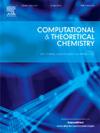金属-空气电池用双网络聚氧乙烯/聚乙烯醇复合水凝胶电解质的机电行为:DFT和分子动力学方法。
IF 3
3区 化学
Q3 CHEMISTRY, PHYSICAL
引用次数: 0
摘要
用于金属空气电池的水凝胶电解质近来备受关注。然而,由于缺乏有关其原子尺度结构-性能关系的优化数据,限制了其实际应用。本文采用密度泛函理论和分子动力学技术研究了聚环氧乙烷(PEO)/聚乙烯醇(PVA)水凝胶电解质的电子、能量、传输和机械性能。PEO 分子链的前沿分子轨道显示了其电子转移潜力,负带隙证实了其稳定性。在 343 K 时,最高结合能为 374.7 × 1010 kcal/mol。最佳交联剂浓度为 0.6 wt%时,结合能依次为 0.6 > 0.8 > 1.0 > 0.4 > 0.2 > 1.2。钾离子(K+)的平均平方位移随时间保持不变,而扩散系数与温度呈线性相关。水凝胶成分对弹性模量有不同的影响。PEO 和 PVA 的结构-性能相关性对开发金属-空气电池的增强型准固体聚合物电解质极为有利。本文章由计算机程序翻译,如有差异,请以英文原文为准。

Electromechanical behavior of dual network polyethylene oxide/polyvinyl alcohol composite hydrogel electrolyte for metal-air battery: A DFT and molecular dynamics approach.
Hydrogel electrolytes for metal-air batteries have recently gained attention. However, absence of well-optimized data on their structure-property relationship at the atomic scale limits their practical application. Density functional theory and molecular dynamics techniques were used to investigate the electronic, energetic, transport, and mechanical properties of polyethylene oxide (PEO)/polyvinyl alcohol (PVA) hydrogel electrolytes. Frontier Molecular Orbitals of the PEO molecular chain exhibited its electron transfer potential, and a negative band gap confirmed its stability. The highest binding energy was 374.7 × 1010 kcal/mol at 343 K. Greater binding energy of the order 0.6 > 0.8 > 1.0 > 0.4 > 0.2 > 1.2 was achieved with optimal value of 0.6 wt% crosslinker concentration. Mean square displacement of potassium ions (K+) remained constant with time while diffusion coefficient exhibited a linear correlation with temperatures. Hydrogel composition had varying effects on elastic moduli. The structure-property correlation of PEO and PVA is extremely beneficial in development of enhanced quasi-solid polymer electrolytes for metal-air batteries.
求助全文
通过发布文献求助,成功后即可免费获取论文全文。
去求助
来源期刊

Computational and Theoretical Chemistry
CHEMISTRY, PHYSICAL-
CiteScore
4.20
自引率
10.70%
发文量
331
审稿时长
31 days
期刊介绍:
Computational and Theoretical Chemistry publishes high quality, original reports of significance in computational and theoretical chemistry including those that deal with problems of structure, properties, energetics, weak interactions, reaction mechanisms, catalysis, and reaction rates involving atoms, molecules, clusters, surfaces, and bulk matter.
 求助内容:
求助内容: 应助结果提醒方式:
应助结果提醒方式:


